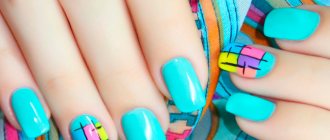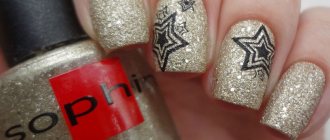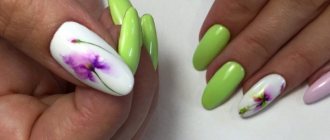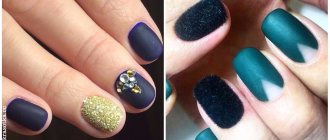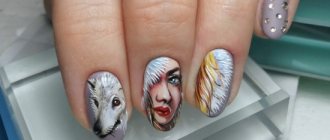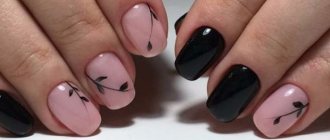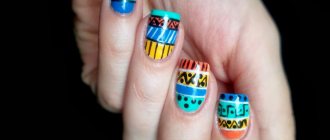Designer manicure techniques excite the imagination. Many of them require real artistic flair, familiarity with the fine arts, and painting skills. Watercolor painting on nails is a subtle type of art.
Art design is improving day by day, setting new trends and tendencies in drawings and ideas for manicure. But watercolor is a subtype of nail art that requires jewelry work.
Attention! Creating watercolor designs on nails takes more time and resources from the artist than a standard gel coating. The complexity of unusual manual techniques may cause an increased price for manicures.
Features of watercolor technique
Watercolor is a nail art technique used to embody design ideas. This method of decorating nails is gaining popularity among the top, leading trends from the end of the 2020 season until the 2022 autumn-winter season, including the spring-summer season. Winter watercolor is just as popular as its other varieties.
Watercolor painting is characterized by a sophisticated design: from the application of faded stains to the effect of artistic painting. The paint creates a unique composition on the nails, maintaining a balance of translucent, pastel colors. Also, watercolor can become rich and colorful if desired and necessary. Depends on the choice of design or pattern.
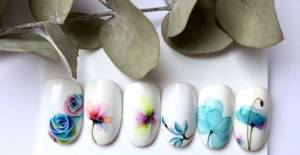
The base plays one of the key roles in the execution of the technique. A correctly selected base allows you to recreate a smoky, multi-dimensional spreading effect on your nails. The effect of watercolor paint can appear in a single form, creating an expressive transition in the composition of the painting. You can also decorate all or several nails with it. This will not negatively affect the overall look, but, on the contrary, will allow the manicure to shine in a creative design.
Does not require an ordinary base. Can be used on both light and dark surfaces. The main thing is that the color of the decor stands out and shines against the background of the main paint.
The coating may be sticky during application. It is necessary to handle it carefully and prudently during the procedure. For fixing, the same lamp is used as for gel polish.
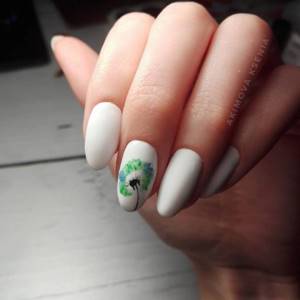
How to draw?
There is no need to wet anything additional; the watercolor effect is achieved due to the light texture of the paints themselves. They can immediately fill the base of the future drawing, using a very light pigment, well diluted with water. Due to its liquid consistency, the paint will lie on the background with a soft transition in intensity.
You can highlight some areas, try to shade the necessary zones in some places.
In fact, the work resembles the work of an artist, except in a smaller format. Gradually, the necessary areas are shaded with colors, the penumbra is painted on, the necessary parts of the picture are highlighted, some are worked on more, others are left blurred. It should be taken into account that the paint will dry very quickly during the work, because it will be diluted with a tiny amount of water. Therefore, for the effect of a smooth flow from one color to another, you must work quickly.
To make the desired image more beautiful, it would be useful to use a ready-made picture. Looking at it, it will be easier to see where and what should be emphasized with the specific shades of paint used. The method of work is notable for the fact that paints can be mixed with each other, obtaining new shades and halftones.
As a rule, such drawings are not overloaded with the number of layers; they are only made brighter by drawing a specific part of the image.
When it is necessary to highlight any elements of a drawing, paints are mixed with white pigment. At the same time, white color can dominate in some of the tones used, since this can create the effect of lightness. However, you should not whiten the texture too much: we must not forget about the translucency of the shades used.
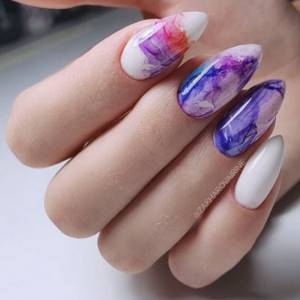
You can add bright spots directly to the nail, using a brush to help them spread to the desired place in the design.
Brushes are changed during work as needed. The larger the area you need to paint with them, the thicker the brush can be. In the end, not everything is emphasized, but only some of the contours and elements of the design, thereby leaving it light and translucent. It is worth considering that the smaller the stroke and the thinner the outline of the line, the more similar the watercolor effect will be.
It is also important to take into account the need to shade the background, for which more water is added to the paint used. This technique will enhance the effect of watercolor on accent nails. When making contours in some places of the drawing, try to put less water on the brush. To do this, use special soft brushes designed for watercolors.
To make the lines smooth and confident, the brush should be positioned perpendicular to the nail.

Watercolor painting can be done in different ways. Sometimes the master makes an ordinary blot on an accent nail, and after it dries, he draws on its contours, for example, in the form of petals, thereby creating a beautiful flower. In addition, you can make a preliminary sketch of the future drawing, drawing approximate contours. The base is filled with a gradual overlay of color and shades. Then, for outlining, sometimes broken lines are applied to the edges of the print, often emphasizing the outline in several tones in addition to black.
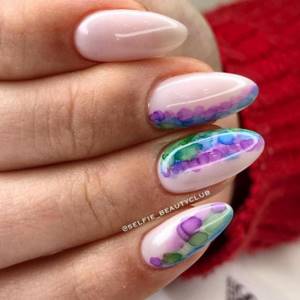
Pros and cons of watercolor technique
If we dwell in more detail on the characteristic advantages of designing with watercolors, we can highlight the arguments in favor of the technique:
1. Incomparable visual effect. Smoky spreading and blurred contours give the nails a sensuality, tenderness and romance. Not every nail art method can beat watercolor in terms of expressiveness and sophistication of execution.
2. Uniqueness, originality. The likelihood that watercolor paintings on nails will be repeated is close to zero. Each composition brings something individual; patterns rarely overlap with each other. This guarantees a personalized design that no one else will have.
3. Volume, multidimensionality. Many people call this technique expressive due to the “blooming bud” effect. Motifs depicted in watercolor seem tangible. And also convex due to the peculiarity of spreading in the middle and saturation at the borders of the contours.
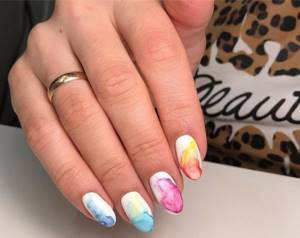
4. The length requirement is not important: painting with watercolors looks good on both long and short nails. Contrary to popular belief, short nails can also provide plenty of space for creativity.
5. Convenience, functionality. To create a nail design in this design, you do not need a huge arsenal of tools. All you need is to stock up on everything you need to start creating beauty.
6. There is no need to use separate methods for removal. Paints along with varnish can be removed with a machine or other handy means in less than fifteen minutes.

Even this dazzling nail design may have its drawbacks:
- The technique cannot be performed without auxiliary tools. You will need to purchase additional things, use special varnishes and brushes.
- Varnish and auxiliary tools will need to be stored in special conditions. And also use with caution to prevent spreading or thickening.
- The palette for applying watercolor paints to nails is not very diverse. This can encourage you to experiment with mixing and combining colors.
- A manicure for short nails will require patience, meticulousness and skill. The process can become more labor intensive due to the short length of the coverage area.
- To master this nail art method, a separate course will be required for those who are encountering subtle fine art techniques for the first time. It is possible that you will have to take a special master class (mk on nail art). From the photo it is difficult to estimate step by step the scale of the work ahead. In this regard, it is advisable to take private or group lessons or study and practice using videos.
It is very interesting and useful to know about manicure with abstraction on nails and 12 fashionable techniques, read the article: - https://uroki-manikura.ru/abstraktsiya-na-nogtyah-foto-novinki-dizajna-risunki-poshagovo/
Tools for watercolor design
The technique of drawing sketches, landscapes or floral motifs cannot do without the necessary assortment at all stages of preparation:
- The greatest attention is paid to the paint, its properties and quality. The durability of the manicure and the unpretentiousness of its appearance depend on the structure. It is better to buy in stores whose specialty is based on nail art products.
- The process of drawing a picture is also impossible to carry out without brushes. If we paint with watercolors, then it is worth acquiring different subtypes: thin, hard, lush, long, short. It is most convenient to purchase a set with the necessary varieties. The thickness of the brush is proportional to the amount of work on the nail plate.
- Foil, paper, and a container of water may also come in handy during the work. When mixing and washing out shades, it’s almost impossible to do without them. You should ensure their availability in advance.
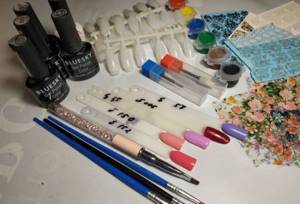
Important: during the entire procedure, the manicure brush must be kept wet. Otherwise, applying paint will be much more difficult.
The whole process can take quite some time. If it is complicated by additional decorations, such as sparkles, rhinestones, rubbing or other techniques, then the work time is extended even more. You should not forget about this by planning your hours in advance.
